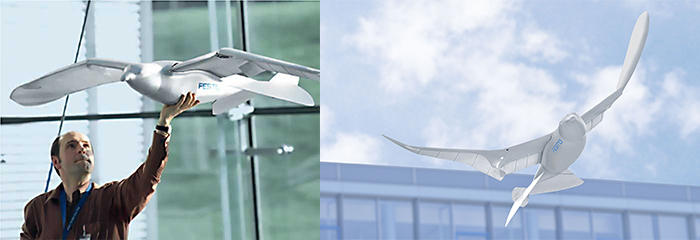
THE COMING OF AGE OF ORNITHOPTERS
This three-part "Can Flying Birds Make Better Robots" blog series presents research and technology initiatives that seem a bit like something out of a sci-fi movie but are in-fact helping researchers understand the physics of flight and its application to the field of robotics and drones.
SmartBird is an autonomous ornithopter created by Festo's Bionic Learning Network with an emphasis on better aerodynamics and maneuverability. It is an ornithopter modeled on the herring gull.
Now that’s a mouthful, so let’s try to break it down!
To begin, an "ornithopter" (which is derived from the Greek words ornithos "bird" and pteron "wing") is an aircraft that flies by flapping its wings. Designers seek to imitate the flapping-wing flight of birds, bats, and insects. Though these machines may differ in form, they are usually built on the same scale as these flying creatures.
Although ornithopters have been recorded as early as the 12th century, two well-known accounts are 1) in 1485, when Leonardo da Vinci began to study the flight of birds. He came to the realization that humans are too heavy, and not strong enough, to fly using wings attached to the arms—and therefore sketched a device in which the aviator lies down on a plank and works two large, membranous wings using hand levers, foot pedals, and a system of pulleys; and 2) in the 1870s, when E.P. Frost made ornithopters. The first models were powered by steam engines, but in the 1900s, he created an internal-combustion craft large enough for a person, but unfortunately it did not fly.

Fast-forward to the 21st century, and we have the SmartBird project by automation technology leader Festo. It was inspired by the herring gull and the book Jonathan Livingston Seagull. Smartbird is actually a robot with articulated wings that function just like their biological counterparts, generating thrust and forward motion.
Built of carbon fiber and polyurethane foam, Smartbird weighs about a pound and has a 6+ foot wingspan which utilizes a bending torso for lifelike directional control. It’s capable of taking off and landing on its own, but it can also be controlled and monitored remotely via ZigBee radio.
Smartbird uses an ingenious motorized drive mechanism to control the up/down movement of the wings by spinning two wheels inside the torso. These are connected, like the wheels on a steam-train, by rods that produce a periodic up-down movement. It also uses torsional motors to adjust the angle of the wings. On the up-stroke, the front edge of the wing points up. This reverses as the wing pushes down, forcing the bird forward.

And lastly, steering is done by moving the tail with a live-bird effect achieved by moving the head from side to side, as if it can see you. Though its inner structure recalls the flying machines of Leonardo da Vinci, it also houses a microcontroller, four servo drives, and a lithium polymer battery and its wing positions are monitored with sensors that relay data to ground operators via a radio link.
As Smartbird was engineered to help decode bird flight and develop a machine that could take off, fly and land using only its own wing-flapping power—unlike Robirds, these robotic birds are not commercially available. Instead, they are a proof of concept that Festo will use to improve the aerodynamics and maneuverability of things such as planes and cars.
Watch Smartbirds Fly on YouTube
Two other robotic bird initiatives discussed in this blog series are Obie, a tiny parrotlet in laser goggles helping scientists discover a new phenomenon in the physics of flight and Robirds, a Netherlands initiative that has created robotic birds of prey that look and fly exactly like their real biological counterparts
